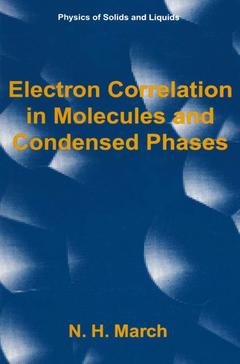Electron Correlation in Molecules and Condensed Phases, Softcover reprint of the original 1st ed. 1996 Physics of Solids and Liquids Series
Langue : Anglais
Auteur : March Norman H.

This book had its origins in lectures presented at EPFL, Lausanne, during two separate visits (the most recent being to IRRMA). The author is most grateful to Professors A. Baldereschi, R. Car, and A. Quattropani for making these visits possible, and for the splendidly stimulating environment provided. Professors S. Baroni and R. Resta also influenced considerably the presentation of material by constructive help and comments. Most importantly, Chapters 4 and 5 were originally prepared for a review article by Professor G. Senatore, then at Pavia and now in Trieste, and myself for Reviews of Modem Physics (1994). In the 'course of this collaboration, he has taught me a great deal, especially about quantum Monte Carlo procedures, and Chapter 5 is based directly on this review article. Also in Chapter 4, my original draft on Gutzwiller's method has been transformed by his deeper understanding; again this is reflected directly in Chapter 4; especially in the earlier sections. In addition to the above background, it is relevant here to point out that, as a backcloth for the present, largely "state of the art," account, there are two highly relevant earlier books: The Many-body Problem in Quantum Mechanics with W.
1. Outline.- 2. Electron Density, Density Matrices and Atomic Properties.- 3. Homogeneous and Inhomogeneous Electron Assemblies.- 4. Localized versus Molecular Orbital Theories of Electrons.- 5. Quantum Monte Carlo Calculation of Correlation Energy.- 6. Quasiparticles and Collective Excitations (Especially Plasmons).- 7. Metal-Insulator Transitions and the Chemical Bond.- 8. Electronic Correlation in Disordered Systems (Especially Liquid Metals).- 9. Magnetically Induced Wigner Solid.- Appendixes.- Appendix to Chapter 2.- A2.1. Density Matrices for Many-Particle Oscillator Model.- A2.2. Atomic Energies from Renormalization of Large-Dimensionality Results.- A2.3. Size-Extensivity, Cumulants, and Coupled-Cluster Equations.- A2.3.1. Different Representations of ?.- A2.3.2. Calculating the Ground-State Energy.- A2.3.3. Derivation of the Coupled-Cluster Equations.- A2.3.4. Independent Mode Approximation.- A2.4. The Hiller—Sucher—Feinberg Identity and Improvement of Cusp Condition.- A2.5. Two Electrons with Coulomb Interaction Moving in an External Oscillator Potential.- A2.5.1. Solution of Schrödinger Equation.- A2.5.2. An Exact Solution.- A2.5.3. Results.- A2.5.4. Some Physical Consequences.- Appendix to Chapter 3.- A3.1. Example of Spin Density Description: Bloch’s Hartree—Fock Treatment.- A3.2. Wave-Number Dependent Magnetic Susceptibility.- A3.3. Koster—Slater-Like Model of Criterion for Local Moment Formation.- A3.4. Dynamic Properties of Jellium.- A3.4.1. Response Function and Screening.- A3.4.2. Random Phase Approximation and Beyond.- A3.5. Static Local-Field and Dielectric Function Applied to Screened Interactions in Metals.- Appendix to Chapter 4.- A4.1. Model of Two-Electron Homopolar Molecule.- A4.2. Dependence on Atomic Number of Correlation Energiesin Neutral Atoms.- A4.3. Correlation Energy of Diatomic Molecules versus Number of Electrons.- A4.4. Effect of Correlation on von Weizsäcker Inhomogeneity Kinetic Energy: Scaling Properties and Molecular Dissociation.- Appendix to Chapter 5.- Appendix to Chapter 6.- A6.2. Thomas—Fermi Model of Static Dielectric Function of Semiconductor.- A6.3. Semiempirical Self-Energy Corrections to Density Functional (LDA) Bands of Semiconductors.- A6.3.1. Summary of Technique.- A6.3.2. Some Specific Examples.- A6.5. Coefficients in the Continued Fraction Expansion.- A6.6. Plasmon Properties and Effective Screened Interaction.- A6.6.1. Screened Interaction.- A6.6.2. Plasmon Properties.- A6.7 Some Difficulties with Plasmon-Pole Approximations and Proposed Remedies.- A6.8 Different Forms of GW Approximations.- A6.8.1. Vertices and Self-Energies.- A6.8.2. Summary of Effects of Exchange and Correlation.- Appendix to Chapter 7.- A7.1. Relation of Resonating Valence Bond and Gutzwiller Methods.- A7.2. Reduction of Hubbard and Emery Models to Effective Spin Hamiltonians.- A7.2.1. Hubbard Hamiltonian with Strong Electron Repulsion Energy.- A7.2.2. Emery Model.- A7.3. Luttinger Liquid: Spinons and Holons.- A7.3.1. Spin—Charge Separation.- A7.3.2. Can a 2D Luttinger Liquid Exist?.- A7.3.3. Spinons, Holons and Gapless Spin Excitations.- A7.5. Electron Liquids Flowing through Antiferromagnetic Assemblies.- Appendix to Chapter 9.- A9.1. Electron Liquids and the Quantized Hall State.- A9.2. Melting Criteria for Three-Dimensional Classical and Quantal Wigner Crystals.- A9.3. Wigner Oscillator in Magnetic Field of Arbitrary Strength.- A9.4. Shear Modulus, Electron Density Profile, and Phase Diagram for Two-Dimensional Wigner Crystals.- A9.4.1. Observation of Magnetically Induced Wigner Solid(MIWS).- A9.4.2. Electron Density Profile and Shear Modulus.- A9.4.3. Limiting Cases: Instabilities and Melting.- A9.4.4. The Magnetically Induced Wigner Solid (MIWS).- A9.4.5. Discussion and Summary.- References.
Date de parution : 06-2013
Ouvrage de 396 p.
15.5x23.5 cm
Mots-clés :
atomic properties; atoms; cluster; crystal; density; diatomic molecule; disordered system; electron; electrons; energy; experiment; molecule; particles; phase; semiconductor
© 2024 LAVOISIER S.A.S.



